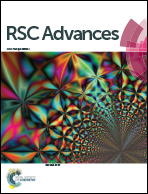Effect of heteroatoms on the optical properties and enzymatic activity of N-doped carbon dots†
Abstract
Carbon dots (CDs) are attractive nanomaterials because of their facile synthesis, biocompatibility, superior physicochemical properties, and low cost of their precursors. Recent advances in CDs have particularly relied on the modulation of their properties by heteroatom doping (e.g., nitrogen). Although nitrogen-doped CDs (N-CDs) have attracted considerable attention owing to their different properties compared to those of the original CDs, the effects of the heteroatom content and types of bonding on the properties of N-doped CDs remain underexplored. In this work, we prepared N-CDs with controlled nitrogen contents, and fully examined their optical properties, enzymatic activity, and toxicity. We demonstrate that (i) the type of carbon–heteroatom bonding (i.e., carbon–oxygen and carbon–nitrogen bonds) can be altered by changing the ratio of carbon to heteroatom sources, and (ii) both the heteroatom content and the heteroatom-bonding character significantly influence the properties of the doped CDs. Notably, N-CDs exhibited higher quantum yields and peroxidase-like activities than the non-doped CDs. Furthermore, the negatively charged N-CDs exhibited negligible cytotoxicity. Such comprehensive investigations on the physicochemical properties of N-CDs are expected to guide the design of N-CDs for targeted applications.


 Please wait while we load your content...
Please wait while we load your content...